Data Monday: Hate Crime In The States
By Deepti Govind
Hate crime in the U.S. reached its highest level in more than a decade in 2019, an FBI report released in November 2020 showed. There were 7,314 hate crime incidents in 2019, up from 7,120 the year before — and the highest since 7,783 in 2008.
“The FBI’s report is another reminder that we have much work to do to address hate in America,” Margaret Huang, the president of the Southern Poverty Law Center (SPLC) said when the FBI’s 2019 data was released, according to AP News.
Cut to 2021, and the nation is still coming to terms with reports over the past month that show hate crimes against the Asian American and Pacific Islander (AAPI) community are on the rise after the covid-19 pandemic struck the world. The New York Police Department (NYPD) saw an eight-fold increase in reported anti-Asian hate crimes compared to the same period in 2019, according a report from the American Bar Association, released on Feb. 17.
While there is no evidence to prove a link between many of these attacks, or that they were motivated solely by anti-Asian bigotry, communities across America are sufficiently concerned. President Joe Biden denounced anti-Asian discrimination in a memorandum published on Jan. 26, shortly after he took office.
What’s more worrisome is several of the recent incidents involved the elderly, including an 84-year-old man from Thailand who died from his injuries on Jan. 30 in San Francisco, and a 91-year-old who was injured after being violently shoved to the ground in Oakland’s Chinatown area.
As the nation continues to deal with the problem of hate crime, here’s a detailed look at various aspects of it – from the legal definition of a hate crime to the laws that protect victims of hate crime, and some key pieces of statistics on it.
How Is Hate Crime Defined?
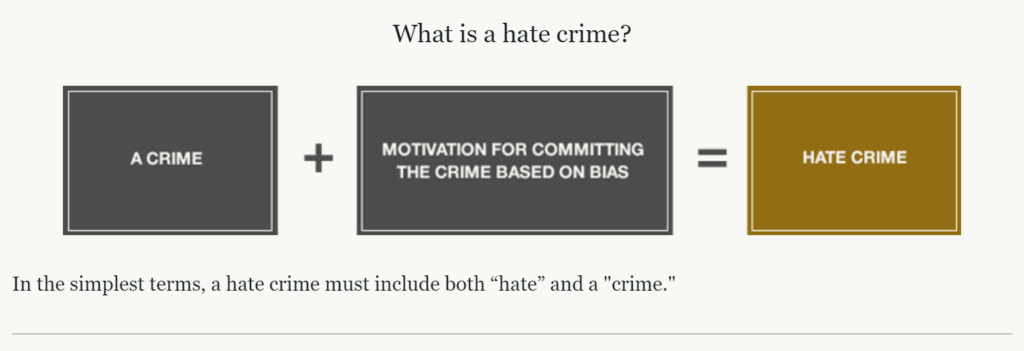
According to FBI: In the simplest terms, a hate crime must include both “hate” and a “crime.” But there’s more to it than just that.
Take the word hate, for instance. While in regular usage, hate may mean rage, anger, or general dislike, in the context of hate crime it means bias against people or groups with specific characteristics that are defined by the law. And crime here often refers to a violent crime, such as assault, murder, arson, vandalism, or threats to commit such crimes. It may also cover conspiring or asking another person to commit such crimes, even if the crime was never carried out, according to the FBI.
Acts of prejudice that do not involve threats, property damage or violence are called a Bias/Hate Incident according to law enforcement.
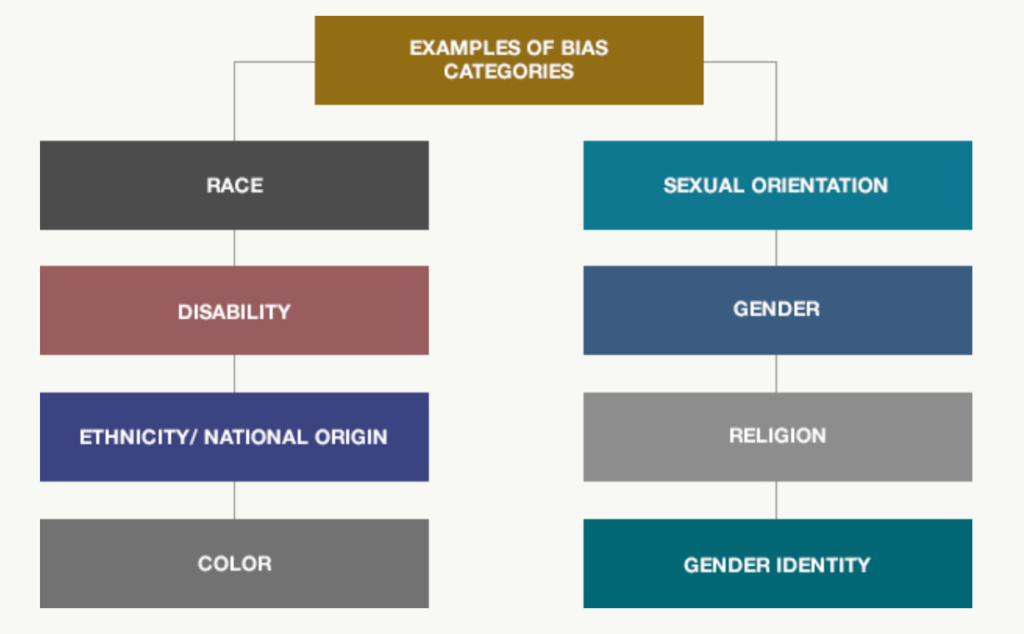
Federal level – At the federal level, hate crime laws include crimes committed on the basis of the victim’s perceived or actual race, color, religion, national origin, sexual orientation, gender, gender identity, or disability.
State level – Most state hate crime laws include crimes committed on the basis of race, color, and religion; many also include crimes committed on the basis of sexual orientation, gender, gender identity, and disability.
The Department of Justice (DOJ) has a list of examples of various kinds of hate crimes; you can access it here for more understanding on what constitutes a hate crime.
What Federal Laws Protect Victims Of Hate Crimes?
Today, there are five key laws that provide protection for victims of hate crime, according to information from the DOJ. The most recent piece of legislation came in 2009 with the Shepard Byrd Act.
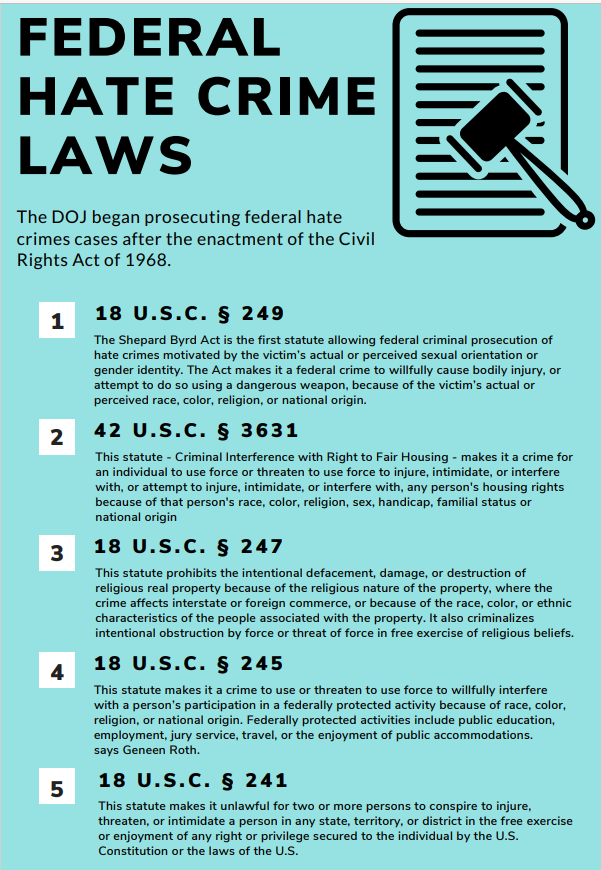
The Matthew Shepard and James Byrd, Jr Hate Crimes Prevention Act was approved by the US Senate as an amendment to the Defense Authorization Act (H.R. 2647) in October 2009. It extended hate crime law to cover gender, disability, sexual orientation and gender identity.
The Act is named after Matthew Shepard and James Byrd Jr., victims of hate crimes. Matthew Shepard was a gay student who was beaten to death in Wyoming in 1998. James Byrd Jr. was an African American man who was murdered by white supremacists in Texas in 1998. A more concise overview of this act can be found here.
State Laws, Codes & Statutes
Hate crime laws in states and territories vary widely across jurisdictions, the DOJ says. But most states and U.S. territories have hate crime statutes, which are enforced by state and local law enforcement in state and local courts.
- Bias motivations: Different jurisdictions define hate crimes to include different bias motivations.
- Penalty enhancements: Laws in some jurisdictions increase the sentence for crimes motivated by identified factors. At least 46 states and the District of Columbia have statutes with penalties for bias-motivated crimes.
- Data collection: Some jurisdictions require collecting data on hate crimes. Data provides better transparency into crimes that are occurring and can help states allocate support and resources to communities in greatest need.
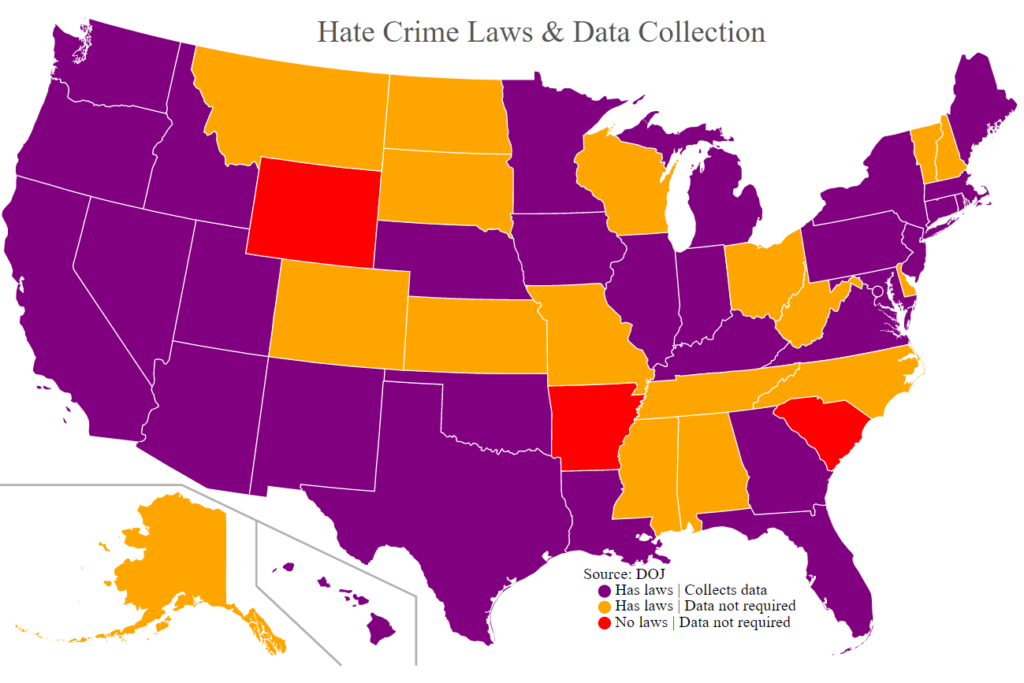
Hate Crime At Record Highs In Recent Years
More than half of all single-bias hate crime incidents reported in 2019 were a result of racial bias, including biases over ethnicity or ancestry, FBI data shows. Hate crimes committed over these factors declined slightly, by just over 2%, in 2019 versus 2018.
However, hate crimes committed over religion – which remained the second-most common factor – was up 7.18% in 2019 compared with the previous year. Those committed over gender identity also soared 17.8% in 2019, although in absolute numbers it stayed smaller than other factors.
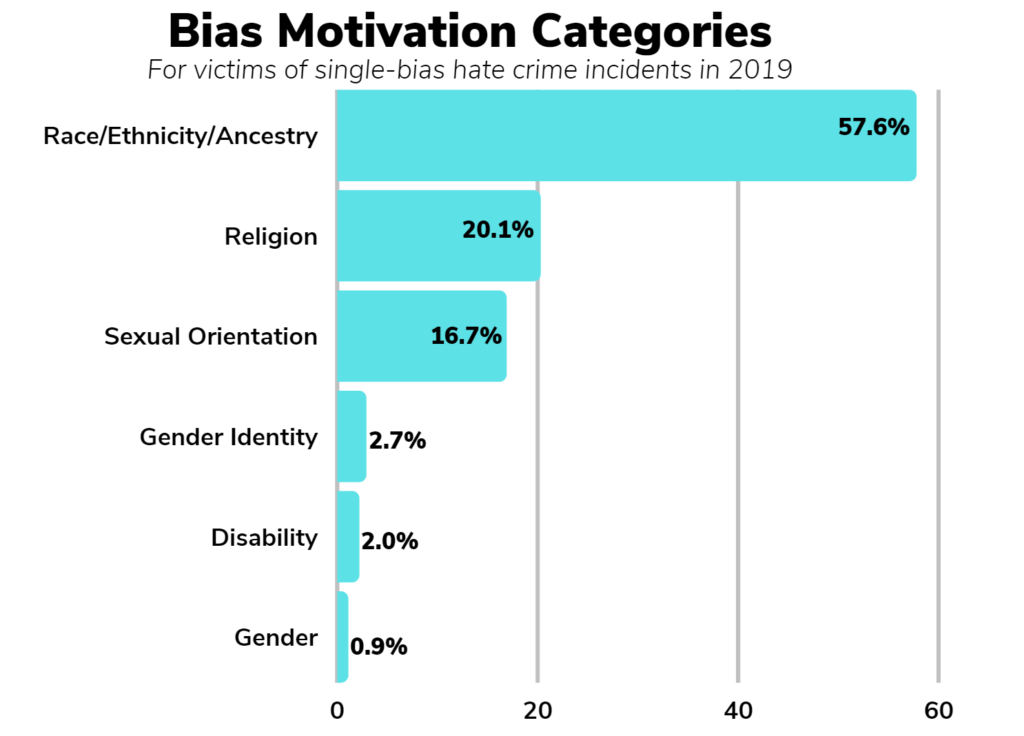
In 2019, the 7,103 single-bias incidents involved 8,552 victims. Apart from those, there were 211 multiple-bias hate crime incidents that involved 260 victims, the FBI data shows. (According to the FBI, a multiple-bias incident is an incident in which one or more offense types are motivated by two or more biases.) Crimes against people accounted for the most number of hate crime offenses reported at 64.4%, while those against property and society stood at 32.8% and 2.8% respectively.
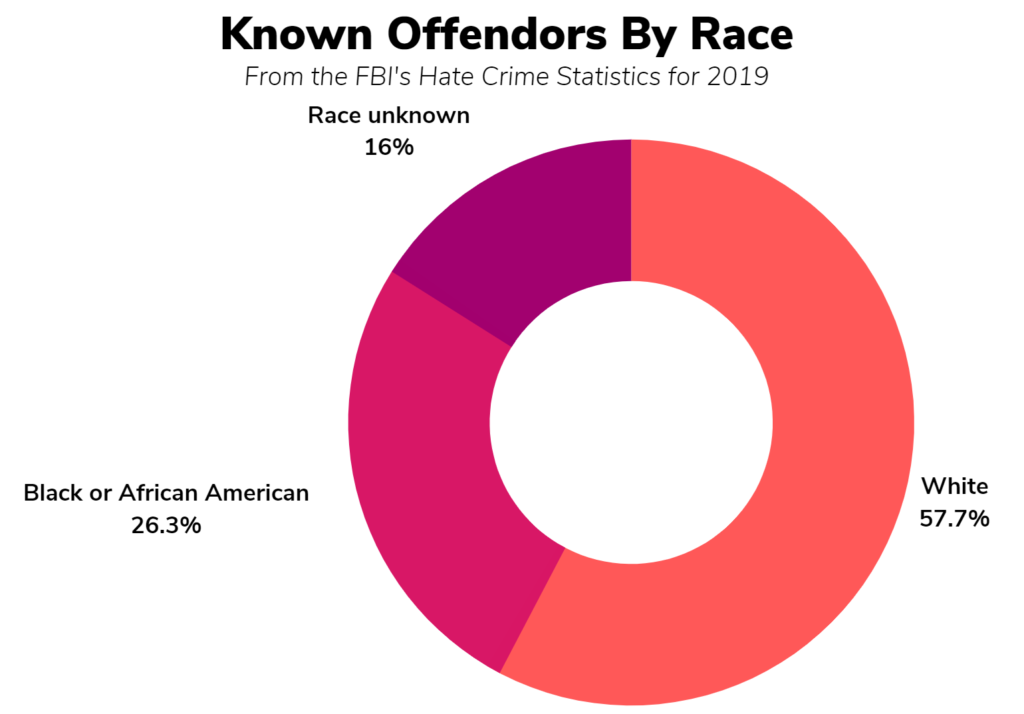
The FBI website says: the term known offender does not imply the suspect’s identity is known; rather, the term indicates some aspect of the suspect was identified, thus distinguishing the suspect from an unknown offender.
Of the 5,443 known offenders for whom ethnicity was reported:
- 33.1% were Not Hispanic or Latino
- 10% were Hispanic or Latino
- 1.9% were in a group of multiple ethnicities
- 55% ethnicity unknown
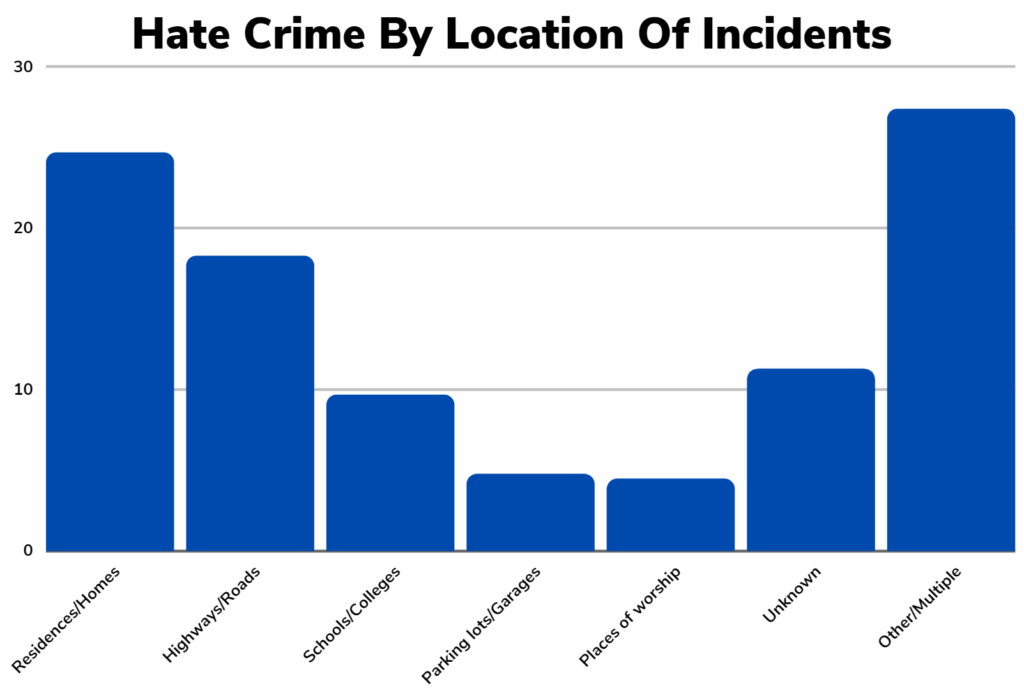
In 2020, the SPLC tracked 838 active hate groups, it said in its annual “Year in Hate and Extremism” report. Though numbers have dropped 11% overall, it said it’s still recording historic highs. In 2015, the numbers jumped from 784 to 892, and they have remained well above 800 for the duration of former president, Donald Trump’s, presidency.
Each year since 1990, the SPLC has published an annual census of hate groups operating within the U.S. “The number is a barometer, albeit only one, of the level of hate activity in the country. The hate map, which depicts the groups’ approximate locations, is the result of a year of monitoring by analysts and researchers and is typically published every January or February. It represents activity by hate groups during the previous year,” it says on its website. The SPLC hate map is definitely worth a look, we’d say.
We leave you with one video and a link to a piece in Time magazine – the video is the one of the horrific, unprovoked assault on 84-year-old Thai man, Vicha Ratanapakdee, who died two days after. The Time magazine piece is of ten Asian Americans reflecting on racism during the pandemic and the need for equality.